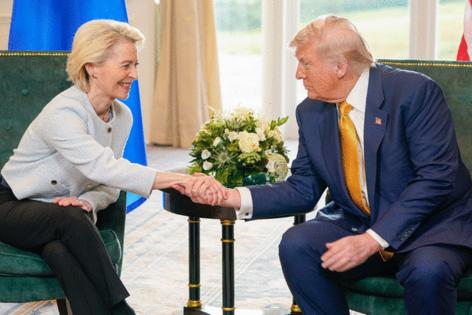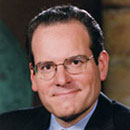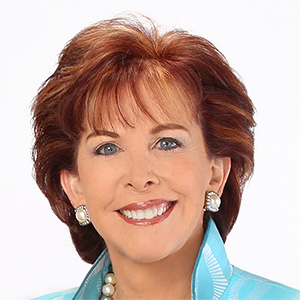Stocks hold at record, dollar jumps on trade hopes: Markets wrap
Published in Business News
Wall Street traders left stocks at all-time highs while the dollar climbed the most since May, with a tariff deal between President Donald Trump and the European Union bolstering hopes for an extension of a China trade truce. Treasuries edged lower.
The start of a week that will set the tone for the rest of the year in markets saw a dollar gauge up nearly 1%. The euro slid the most in over two months. The S&P 500 briefly topped 6,400 to close little changed. Treasuries barely budged amid mixed results from U.S. debt sales. Oil rose as Trump said he’d shorten his timeline for Russia to reach a truce with Ukraine.
In the run-up to the Aug. 1 U.S. tariff deadline, traders will go through a raft of key data from jobs to inflation and economic activity. The big event comes Wednesday, when the Federal Reserve is expected to keep rates unchanged. Then there’s a string of big-tech earnings, with four megacaps worth a combined $11.3 trillion reporting results.
“This is about as busy as a week can get in the markets,” said Chris Larkin at E*Trade from Morgan Stanley. “This week could make or break that momentum in the near term.”
U.S. and Chinese officials finished the first of two days of talks aimed at extending their tariff truce beyond a mid-August deadline and hashing out ways to maintain trade ties while safeguarding economic security. Canada Prime Minister Mark Carney said his government is still deep in trade talks with the Trump administration.
The Treasury jacked up its estimate for federal borrowing for the current quarter to $1 trillion, mainly due to distortions from the debt limit. On Wednesday, the department will announce its plans for note and bond sales over coming months — which dealers widely see as staying unchanged.
Speaking in Scotland on Sunday to announce the EU deal, Trump gave a brief update on Washington’s relations with Beijing. “We’re very close to a deal with China. We really sort of made a deal with China, but we’ll see how that goes,” he said without elaborating.
“It is possible that as more trade deals are announced, the level of uncertainty that has hovered over business and the economy will ease,” said Brent Schutte at Northwestern Mutual Wealth Management Co. “Additionally, the impact of final trade deals could be less than originally forecast after the April 2 announcement of reciprocal tariffs.”
To Thierry Wizman at Macquarie Group, while the dollar’s strength today may reflect the perception that the new EU deal is lopsided in favor of the U.S., it may also reflect a feeling that America is reengaging with its major allies.
“Whether we agree or not with the use of tariffs and the deals announced, we are getting the big ones out of the way which will allow American businesses to adjust and plan, for better or worse,” said Peter Boockvar at the Boock Report. “And we can now focus on how this all plays out.”
Fed Chair Jerome Powell and his colleagues will step into the central bank’s board room for a two-day meeting starting Tuesday to deliberate on rates at a time of immense political pressure, evolving trade policy, and economic cross-currents.
In a rare occurrence, policymakers will convene in the same week that the government issues reports on gross domestic product, employment and the Fed’s preferred price metrics. Forecasters anticipate the heavy dose of data will show economic activity rebounded in the second quarter.
While the stock market is moving sideways after a solid run, “if we get no surprises in earnings and some dovish comments by the Fed, it’s likely we’ll see yet more new highs by the end of the week,” said Louis Navellier, chief investment officer at Navellier & Associates.
“We do not expect the Federal Reserve to cut interest rates on Wednesday, but it’s possible that they make a stronger signal that cuts are on the horizon in the fall, especially as the inflation data continues to stay muted even in this tariff environment,” said Rick Gardner at RGA Investments.
Gardner also says that while stock market valuations are high, that in and of itself is not a reason why valuations can’t expand even further from here.
In fact, this earnings season is off to a solid start, and all eyes will be on results from Microsoft Corp. and Meta Platforms Inc. on Wednesday, and Apple Inc. and Amazon.com Inc. on Thursday.
So far, Corporate America appears to be taking tariffs in stride. With about a third of S&P 500 firms having reported, roughly 82% have beaten profit forecasts, on track for the best quarter in about four years, data compiled by Bloomberg Intelligence show.
Progress in trade negotiations will take the S&P 500 to a third consecutive year of 20% gains, according to Oppenheimer Asset Management’s John Stoltzfus, a feat unseen since the late 1990s. He raised his year-end target for the U.S. benchmark to 7,100.
Some market forecasters including Morgan Stanley’s Michael Wilson have turned more optimistic about the S&P 500 as they expect earnings to remain upbeat.
The technical evidence suggests a broadening of participation in equities off the April low, according to Craig Johnson at Piper Sandler.
“Despite a slight easing in momentum as investors await earnings, the combination of several major indices at all-time highs and improving market breadth continues to draw investors off the sidelines, offering opportunities to buy the dip,” he said.
At RBC Capital Markets, Lori Calvasina says it would be premature to write off the impact of tariffs on inflation and corporate earnings.
“It also poses a risk to the path of stock prices if company outlooks for 2026 don’t end up being as rosy as investors have been anticipating,” she noted.
The S&P 500 is trading around 22.5 times projected earnings, compared to a 10-year average of 18.6. That’s sparked concerns that there may be little room for error.
The stock market’s stunning rebound and resilience have again emboldened equity investors, who have developed muscle memory around ‘buying the dip’,” according to Lisa Shalett at Morgan Stanley Wealth Management.
“With volatility having decoupled from stress indicators, passive indexes have ground to new highs, while the most speculative corners of the market have begun to lead,” she said. “Complacency is elevated, and valuations are rich. In this environment, we want to be stock-pickers.”
To Mark Hackett at Nationwide, this may be the most compelling intersection of technical momentum and fundamental strength we’ve seen in a long time.
“The S&P hasn’t had a 1% move in over a month and yet bears have capitulated,” he said. “No one’s willing to short this market, and even typically skeptical investors are getting pulled in. While it’s not a blow-off top yet, the odds of that happening are rising.”
If sentiment keeps shifting and dip buyers remain aggressive, we could see a classic melt-up – and any near-term weakness over the next several weeks is likely to be bought aggressively, he said.
“However, for now, bears are hibernating through the summer,” Hackett concluded.
“We would lean toward being more bullish than bearish on U.S. stocks through year-end, but not outside of a balanced portfolio based on risk,” said Anthony Saglimbene at Ameriprise. “However, that view is contingent on positive corporate profitability and economic growth this year, avoiding worst-case tariff scenarios, and investors remaining willing to ‘buy the dip’.”
Markets have found reassurance in several developments, according to Invesco Global Market Strategy Office.
“For one, the worst fears that manifested around trade in early April haven’t materialized, and key trade agreements are being signed,” the strategists said. “Tariff rates remain vastly elevated compared to last year, but they appear manageable. In our view, it’s likely that the cost can be shared between businesses and consumers without a meaningful impact on growth or inflation.”
Invesco strategists also noted that what should really matter for stocks in the medium and long-term is earnings.
“After a strong market rally, investors should prepare for renewed volatility in the near term,” said Mark Haefele at UBS Global Wealth Management. “Potential market dips could offer an opportunity for investors to build long-term exposure to stocks.”
Corporate Highlights:
—Samsung Electronics Co. will produce AI semiconductors for Tesla Inc. in a new $16.5 billion pact that marks a win for its underperforming foundry division.
—Texas Instruments Inc. was upgraded to outperform at Wolfe Research, which said the chipmaker is “near the end” of a spending cycle.
—Cisco Systems Inc. was downgraded to inline at Evercore, which mentioned valuation following recent gains.
—Nike Inc. was raised to overweight at JPMorgan Chase & Co., which cited the earnings impact of the sportswear maker’s five-pronged multi-year recovery plan.
—Albertsons Cos. demanded that Kroger Co. provide details on personal conduct that led the company to replace its chief executive officer, who shepherded the failed $24.6 billion takeover that’s now the focus of litigation between the two companies.
—PayPal Holdings Inc. will soon allow businesses to accept more than one hundred cryptocurrencies at checkout.
—Roche Holding AG plans to test whether an experimental medicine can prevent Alzheimer’s disease symptoms in high-risk people, its latest investment in one of the most failure-prone areas of drugmaking.
—Arrowhead Pharmaceuticals Inc. said Monday that it’s owed a $100 million milestone payment from Sarepta Therapeutics Inc. within the next two months, pressuring the beleaguered biotech company just days after it stopped selling its biggest drug due to safety concerns.
—EssilorLuxottica SA posted better-than-expected revenue in the second quarter, as the world’s biggest eyewear maker showed strong gains in Europe and pressed ahead with its smart-glasses initiative.
—Warner Bros. Discovery Inc. announced the names of the two companies resulting from a planned separation of the streaming and studios business from its cable-TV networks.
Some of the main moves in markets:
Stocks
—The S&P 500 was little changed as of 4 p.m. New York time
—The Nasdaq 100 rose 0.4%
—The Dow Jones Industrial Average fell 0.1%
—The MSCI World Index fell 0.3%
—Bloomberg Magnificent 7 Total Return Index rose 0.8%
—The Russell 2000 Index fell 0.2%
Currencies
—The Bloomberg Dollar Spot Index rose 0.8%
—The euro fell 1.3% to $1.1592
—The British pound fell 0.6% to $1.3355
—The Japanese yen fell 0.6% to 148.56 per dollar
Cryptocurrencies
—Bitcoin fell 0.6% to $118,128.17
—Ether fell 0.6% to $3,802.22
Bonds
—The yield on 10-year Treasuries advanced two basis points to 4.41%
—Germany’s 10-year yield declined three basis points to 2.69%
—Britain’s 10-year yield advanced one basis point to 4.65%
Commodities
—West Texas Intermediate crude rose 3% to $67.10 a barrel
—Spot gold fell 0.6% to $3,317.25 an ounce
©2025 Bloomberg L.P. Visit bloomberg.com. Distributed by Tribune Content Agency, LLC.












Comments